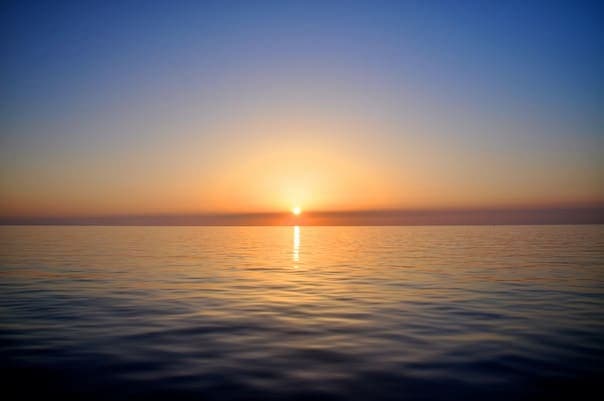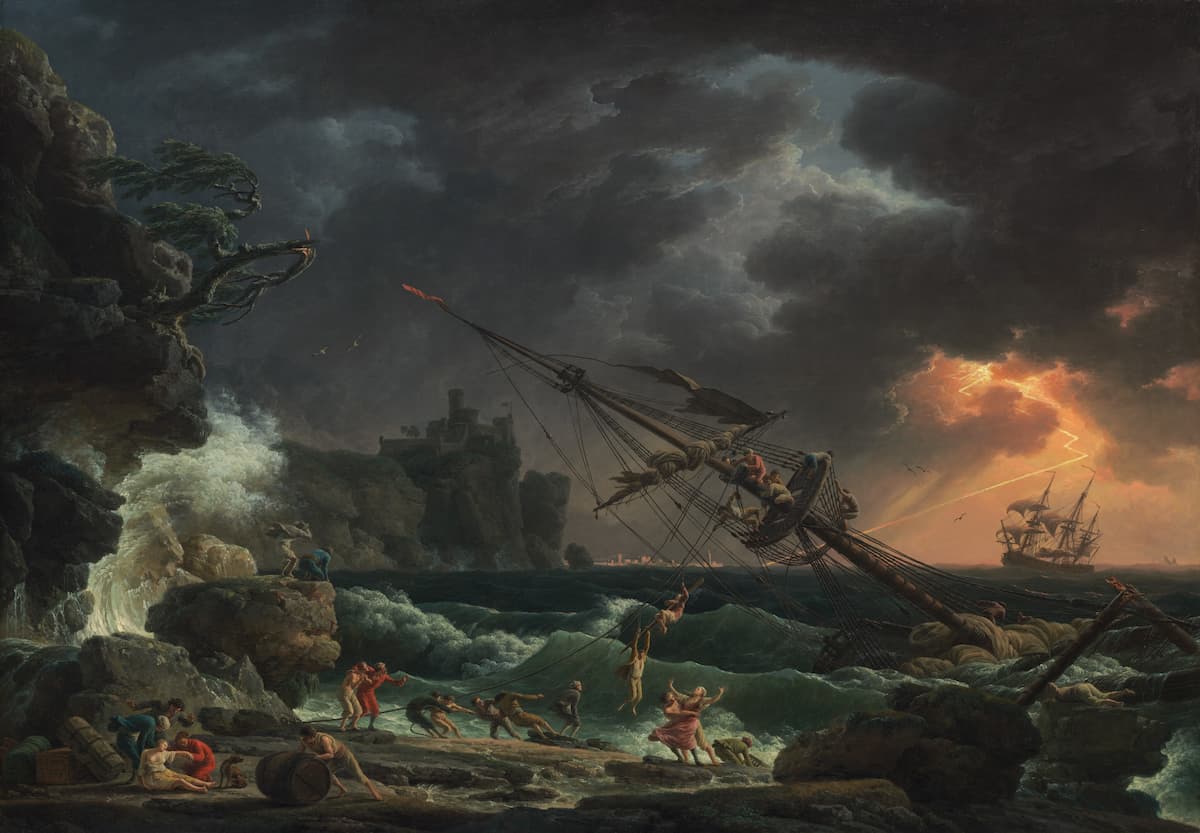Today we’re looking at pieces of classical music inspired by the sea.
We’ll be listening to the work of composers who made musical waves, capturing the sea’s tranquility and its tumult. Anchors aweigh!
Ludwig van Beethoven: Calm Sea and Prosperous Voyage (1815)
Calm Sea and Prosperous Voyage is a cantata for orchestra and chorus.
In it, Beethoven set two poems by Goethe called “Meeresstille” (“Calm Sea”) and “Glückliche Fahrt” (“Prosperous Voyage”). He combined the two poems into one movement.

© livingoceansfoundation.org
The first poem is about a sailing ship that has to pause its journey due to dangerously calm winds, and the second is about the trip resuming once the wind returns.
This work was first performed in 1815 and published in 1822, a few years before Beethoven’s death.
Felix Mendelssohn: Calm Sea and Prosperous Voyage (1828)
In 1828, Mendelssohn was inspired by the same two Goethe poems that Beethoven had been.
Mendelssohn described the opening to his version like this: “A pitch gently sustained by the strings for a long while hovers here and there and trembles, barely audible… The whole stirs sluggishly from the passage with heavy tedium. Finally, it comes to a halt with thick chords, and the Prosperous Voyage sets out.”
Then, when the ship arrives at its destination, “all the wind instruments, the timpani, oboes and flutes…[play] merrily to the end.”
Charles-Valentin Alkan: The Song of the Mad Woman on the Sea Shore (ca 1844)
During his lifetime, eccentric pianist Charles-Valentin Alkan was often mentioned in the same breath as giants like Chopin and Liszt.
However, in 1848, after he was passed over to become head of the Paris Conservatoire, he largely withdrew from society.
From that point on, he shifted his focus to composition and wrote a variety of groundbreaking works. (For instance, he embraced his heritage and became one of the first composers to quote Jewish music in his art music.)
In this prelude, the constant sea waves are represented by the low notes and the woman’s repetitive song by the higher ones.
Edvard Grieg: Stormy Evening at Sea from Peer Gynt Suite No. 2 (1875)
In 1867, Norwegian author Henrik Ibsen wrote a play in verse called Peer Gynt, which traces the eponymous character’s journey from Norway to an African desert and back.

Claude-Joseph Vernet: The Shipwreck, 1772 © Patrons’ Permanent Fund and Chester Dale Fund
It was premiered in current-day Oslo in 1876, and Grieg’s music was played along with it. Grieg later extracted orchestral suites from the music he’d written for the play.
This movement portrays Peer Gynt’s shipwreck.
Edward MacDowell: Sea Pieces (1898)
Sea Pieces by American composer Edward MacDowell consists of eight short pieces for solo piano. Each one has a sea-related subtitle and epigraph.
The second movement is called “From a Wandering Iceberg” and the sixth “From the Depths.”
They are highly attractive, charming turn-of-the-century miniatures that portray different traits of the sea.
Edward Elgar: Sea Pictures (1899)
Sea Pictures is a song cycle consisting of five songs for contralto and orchestra.
While writing it, Elgar set poems by Elizabeth Barrett Browning, three other English poets, and his wife, Alice.
Fun fact: famous English alto Clara Butt sang the premiere dressed as a mermaid!
Frederick Delius: Sea Drift (1903-04)
While writing Sea Drift, English composer Frederick Delius was inspired by Walt Whitman’s famous poem “Out of the Cradle Endlessly Rocking” from Leaves of Grass.

“Leaves of Grass” 2nd edition, 1856
The poem’s narrator, a young boy, observes a pair of birds nesting. One day, one of the birds disappears forever, and the one left behind sings tragic songs to the sea.
The boy, overcome by the lonely bird’s plight, rushes down to the sea, grappling with difficult new ideas about death and abandonment.
The work was premiered in 1908 and was written for baritone, chorus, and orchestra.
Ralph Vaughan Williams: Symphony No. 1: A Sea Symphony (1903-09)
English composer Ralph Vaughan Williams composed A Sea Symphony in his thirties. It’s written for chorus, orchestra, and baritone and soprano soloists.
It lasts a little over an hour and is renowned as one of the first symphonies to use a chorus throughout.
Like Delius, Vaughan Williams set poetry by Walt Whitman. The texts heard in A Sea Symphony come from Whitman’s Leaves of Grass.
Frank Bridge: The Sea (1910-11)
Frank Bridge was a violin-playing composer active in Britain in the early twentieth century. He may be more famous today for being the composition teacher of composer Benjamin Britten (who appears later on this list).
The Sea is a twenty-minute-long orchestral suite.
Bridge wrote his own program notes for the piece.
Of the opening, he wrote, “Seascape paints the sea on a summer morning. From high drifts is seen a great expanse of waters lying in the sunlight. Warm breezes play over the surface.”
Grace Williams: Sea Sketches (1944)
Grace Williams was a Welsh composer born in 1906. In 1926, she began studying at the Royal Conservatory of Music, studying under Ralph Vaughan Williams.
She spent most of the 1930s teaching music, but after she and her students were evacuated from London during the Blitz, she began spending more time composing.
Sea Sketches, which portrays the ocean’s ever-changing moods, was one of her first pieces that showed her compositional maturity.
After the war, she devoted herself almost entirely to composition. In 1949, she became the first British woman to write a movie soundtrack.
Benjamin Britten: Four Sea Interludes from Peter Grimes (1945)
In the late 1930s, Frank Bridge’s student, Benjamin Britten, departed Britain with his friend, tenor Peter Pears. During a tour of America, Britten and Pears became lovers.
While in the United States, they became deeply homesick for Britain. Despite the dangers presented by the war, they returned in 1942, registering as conscientious objectors.
Between his status as a conscientious objector and his homosexuality, Britten was thinking a lot during this time about the idea of being an outsider and the pressure of societal judgment.
These thoughts manifested in his opera Peter Grimes, a 1944 masterpiece set in a judgmental oceanside town. At the premiere, Grimes was played by Pears.
He captured the mood of the opera in his Four Sea Interludes for Orchestra, which were scattered throughout the opera before being excerpted in concert form.
Virgil Thomson: Sea Piece with Birds from Three Pictures for Orchestra (1949)
American composer Virgil Thomson put together three pieces when assembling his Three Pictures for Orchestra.
He wrote that in the third and final piece, Sea Piece with Birds, he aimed “to portray the undertow of the sea, the surface tension of waves, and the flight of birds. The musical textures are of double and triple chromatic harmonies, and the form is free, with no thematic repetition.”
Walter Piston: Seaside from Three New England Sketches (1959)
In 1959, American composer Walter Piston was commissioned by the Worcester County Musical Association to write Three New England Sketches.
The work is divided into three movements: Seaside, Summer Evening, and Mountains.
However, despite attaching those titles to the work, Piston resisted the idea that this music was strictly programmatic.
He wrote that the movement titles “were the subjects that prompted me to compose. I did not intend to openly suggest the subject matter, but a man came up to me, following the premiere, and said, ‘I hope you don’t mind my saying that I smelled clams during the first movement.’ I said, ‘No, that is quite all right. They are your clams.’ Each individual is free to interpret as he wishes.”
Howard Hanson: Symphony No. 7, Sea Symphony (1977)
In the 1970s, American composer Howard Hanson was commissioned by the National Music Camp in Interlochen, Michigan, to write a choral symphony celebrating their fiftieth anniversary season.
After the other entries on this list, it shouldn’t come as a surprise that Hanson was inspired by Walt Whitman’s poetry!
Although Hanson was an elderly man at the time, he threw himself into the project wholeheartedly:
“I had wanted to write the piece all my life, and when I finally got at it – I was eighty – I had no trouble. It came out just as if I were thirty or even twenty-five, and I had no inhibitions about it. I didn’t work on it, I didn’t go over it, I didn’t redo it – whoosh – it came like that!”
Hanson died a few years later, in 1981.
Toru Takemitsu: Say Sea, Take Me! from Quotation of Dream (1991)
Japanese composer Toru Takemitsu wrote Quotation of Dream in 1991 for two pianos and orchestra.
Its subtitle is Say Sea, Take Me!, a line from a poem by Emily Dickinson in which the narrator compares herself to a river and her lover to an ocean that the river empties into.
The work is magical and includes many references to another famous seagoing classic – Debussy’s La Mer.
Conclusion
As we look at these pieces, from Takemitsu’s delicate and enchanting Quotation of Dream to the tumult of Vaughan Williams’s forces bellowing “behold the sea!” in his Sea Symphony, it’s clear that the sea has been one of the best muses in classical music history.
What’s your favourite piece of classical music about the sea?
For more of the best in classical music, sign up for our E-Newsletter

